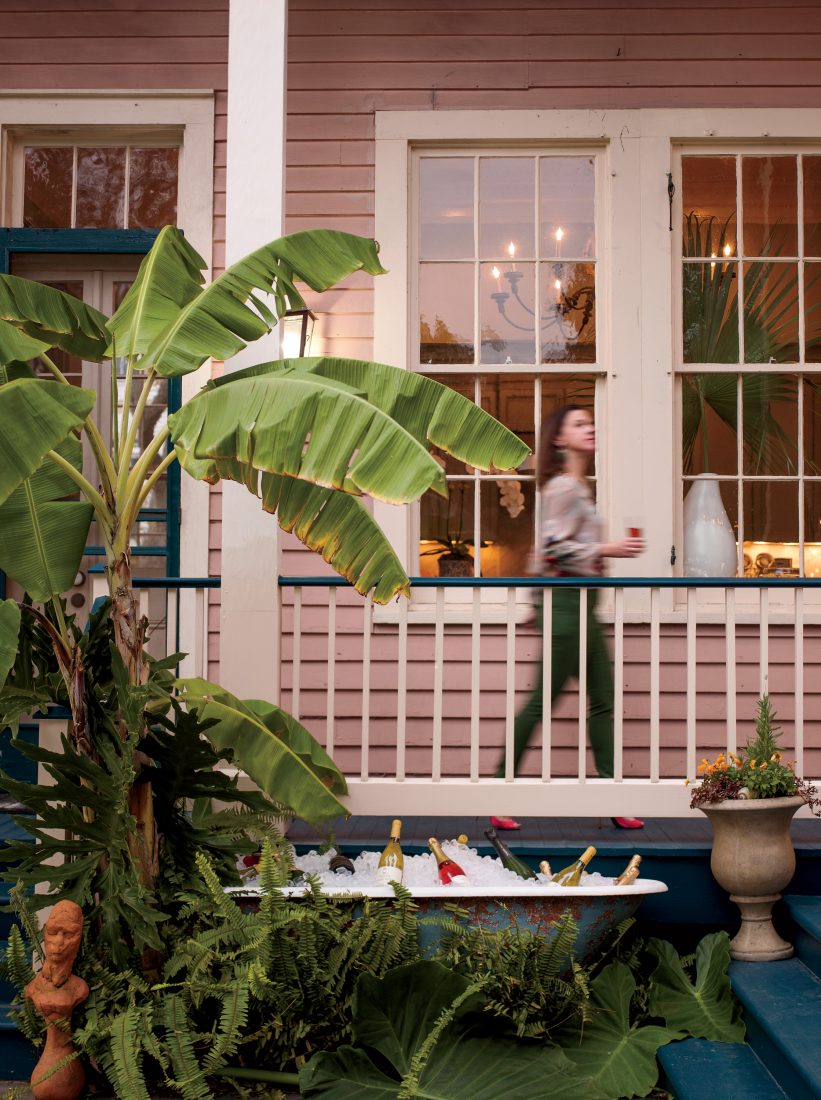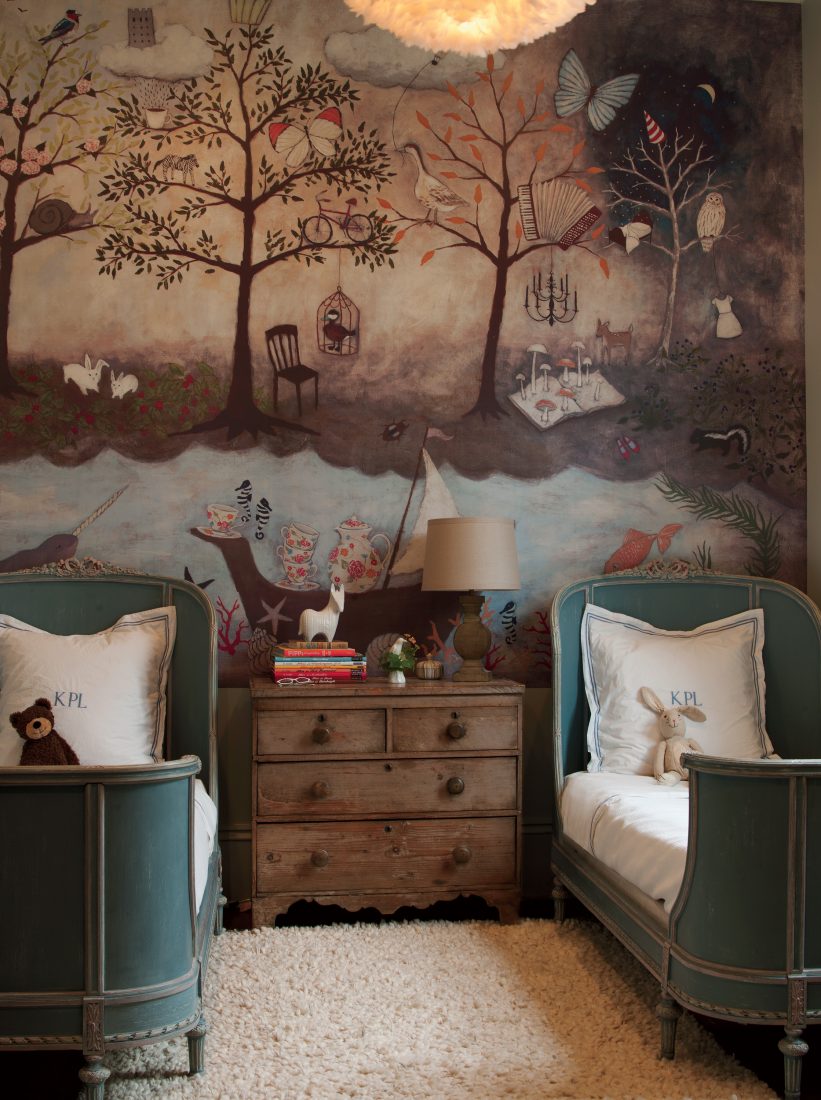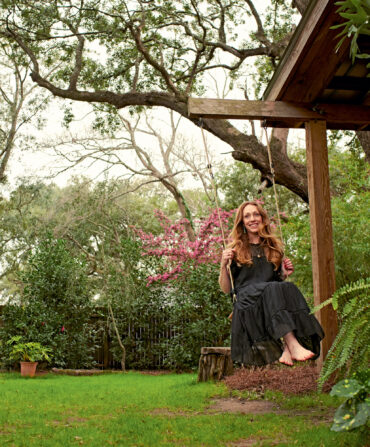Perhaps only in New Orleans could a home embody such colorful contrasts. At Alexa Pulitzer’s Bayou Saint John residence, Southern charm blends with Italian flair, jazz salons coexist with hushing palms, cool grays set off brilliant golds, and 150-year-old floorboards, soapy with age, underscore vibrant modern paintings, mostly abstracts by the acclaimed Leonard Flettrich, Pulitzer’s late grandfather.
An artist herself who creates luxury paper goods emblazoned with all manner of Southern flora and fauna, Pulitzer comes from a long line of creative New Orleanians. “For my sixteenth birthday,” she says, “I wanted a car; I got a membership to the Museum of Modern Art.” While working with her father in the family’s men’s accessories company (Wembley, once the world’s largest necktie maker), she began traveling to Italy in the summers. A college year abroad in Florence led to an apprenticeship with Ratti, the silk company that services Versace and Prada. When she came back to the city she’d left at fourteen, she met a man named Seth Levine who reminded her what home felt like.

Photo: Morgan & Owens
Open-Door Policy
Pulitzer’s breezy, welcoming kitchen
The Victorian center-hall came into their lives three years ago, after four years of searching. Already residents of Bayou Saint John, they knew they wanted to stay in this diverse neighborhood that’s walking distance from the French Quarter, so they jumped on a rambling fixer-upper. It was a warren of rooms with a blocked-off kitchen, a nearly inaccessible staircase, and a yard overhung with old pines and sycamores. Undeterred, Pulitzer and her husband, who have two young children, reconfigured the floor plan—the front half dating from 1862, and the kitchen and upstairs from 1905—to accommodate a bustling family. The renovation focused on opening up the space, pulling the outside in, and centering the interior design around her art collection. “I don’t have a lot of belongings, I don’t have a lot of furniture; I have great art,” she says. “I used that as the starting point for both the color scheme and the floor plan.” One massive painting needed a wall, so she filled in an extraneous doorway to create space for it. She chose paint colors by matching hues across a dozen paintings.
Photo: Morgan & Owens
A bedroom with a mural by Rebecca Rebouché
1 of 4
Photo: Morgan & Owens
A portrait by New Orleans artist Shelly Hesse
2 of 4
Photo: Morgan & Owens
An abstract painting by Pulitzer’s grandfather
3 of 4
Photo: Morgan & Owens
The designer with one of many paintings by her grandfather Leonard Flettrich throughout her home.
4 of 4
Pulitzer has also carved out space for her own art: Her stationery and design business is housed in the front parlors, swamped with sun. It’s important to be able to close the doors, though they aren’t impenetrable. Just because she’s on the phone with a client doesn’t mean her children don’t “want to run into my office and say, ‘Mama, are you done yet?’” But mostly she feels lucky to have everything she loves at hand: her art, her kin, her friends whom she regularly gathers for dinner parties that stretch down tempo rary tables in the center hall and for jazz salons with Preservation Hall musicians on the saxophone or piano. And when she needs a little peace? She can slip through the doors out to the garden, with its grove of bananas, blood oranges, pomegranates, lemons, figs, and satsumas.
When you live in a three-hundred-year-old city, you learn to embrace the old, from the collectibles found on Royal Street or Magazine Street to those floorboards. “They’re warmer on my feet,” Pulitzer says. From the home’s original fixtures, she held on to a geometric sink and an old cast-iron tub, which she moved outside and repurposed as a champagne cooler for parties. Her favorite object in the house—putting aside her grand father’s paintings, which light the walls with depth and energy—is a teal art deco baker’s table topped with marble and zinc that she converted into a bar. This is where the spirit of the house resides, even when the revelers are absent. “My husband and I were going out Saturday night,” she says, “and we sat up here just the two of us and had a toast instead.”
In a city legendary for architectural marvels, Pulitzer hardly takes her house for granted. “It’s not a materialistic thing,” she says. “It’s a sense of pride that I have a small bit of New Orleans I’ve made my own.” Through the window behind her, a palm catches a breeze and begins to shimmy. “There’s a lot of celebration in these walls.”












